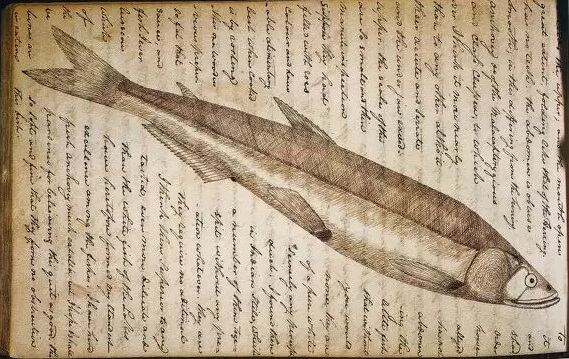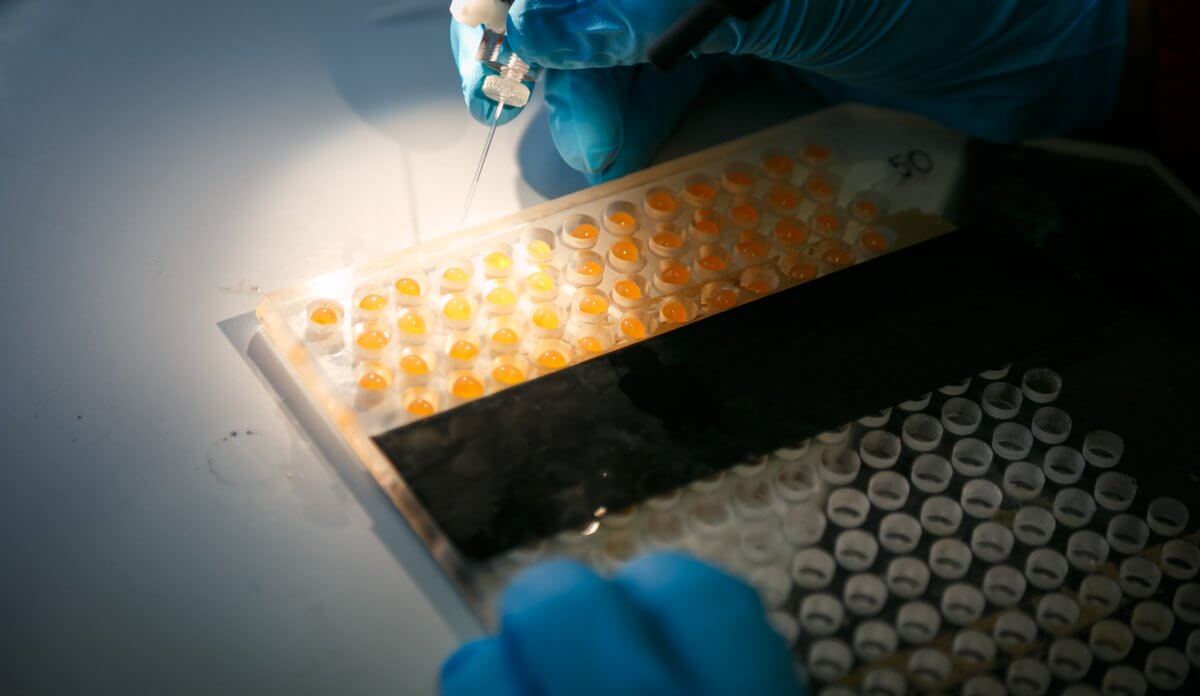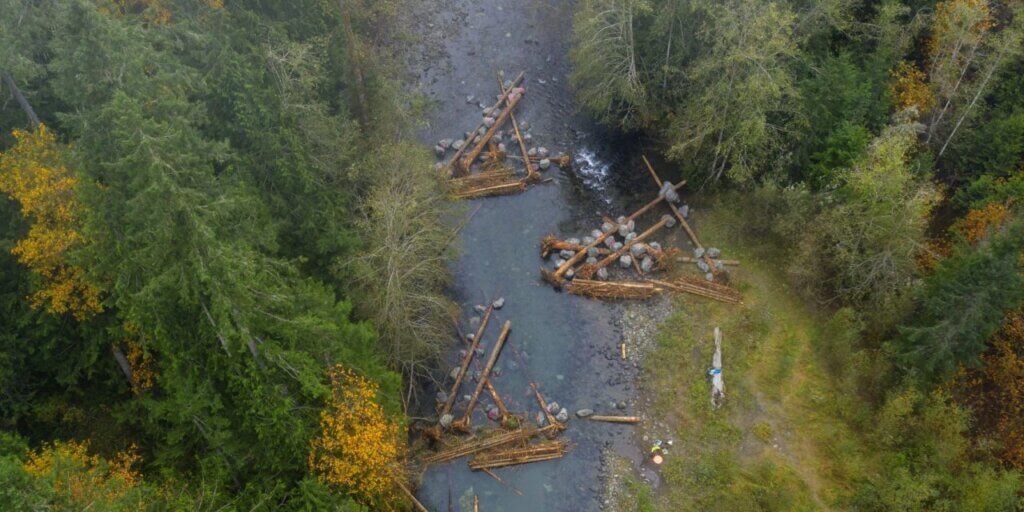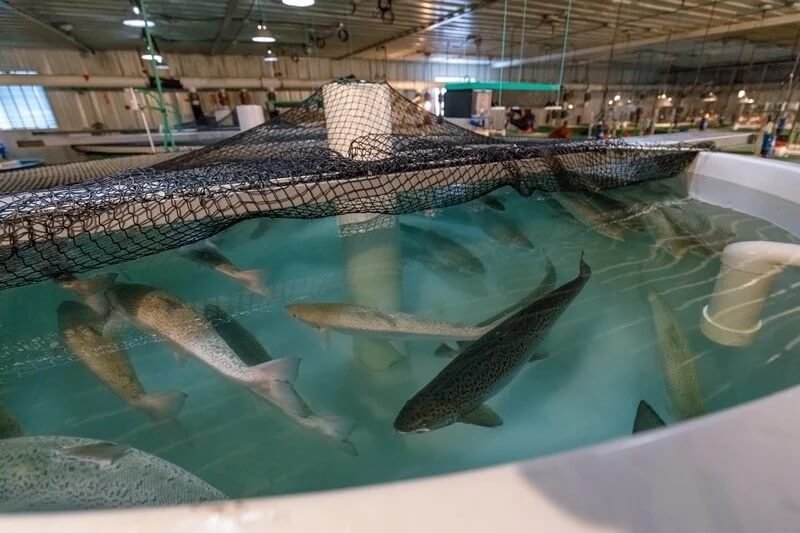We know why salmon are in trouble. It started with impacts from overfishing, habitat fragmentation and destruction by dams, and unsustainable agriculture and forestry practices, followed by competitive and inbreeding interactions with hatchery fish, and disease and parasites from sea pen escapees. Along with climate change, all these have combined to cause massive crashes in wild salmon numbers.
Modern biotechnology can not only help wild salmon, but also other aquatic species and ecosystems. One would think developments that could eliminate at least some of these threats would be universally welcomed, yet opponents claim they bring all manner of dangers and threats to wild fish. An interdisciplinary group of scientists (we are among them) has taken a closer look. The facts are worth examining.
In the autumn of 1805, as Lewis and Clark passed through the confluence of the Snake and Columbia rivers on their way to the Pacific, they “were astonished at the numbers of salmon in the river… the water was so clear that no matter how deep the river, the bottom was clearly visible.” Historical accounts indicate salmon runs on the Columbia averaged 11 to 16 million fish, of which as many as half may have been harvested by Native Americans. Wild salmon numbers have declined since by 95 to 98 percent and continue their downward trajectory.

The declines began more than two centuries ago, fueled by overharvesting, habitat degradation and fragmentation, then exacerbated by dam construction throughout the 19th century, first for irrigation, then for hydroelectric power, that increased pressure on salmon numbers, escalating through the 20th century with the building of huge federal hydropower dams commencing in the 1930s. Dams block or restrict access of salmon to historical spawning grounds and profoundly alter water quality and riparian (riverside) ecology, commonly obliterating spawning habitats and favoring introduced nonnative competitors. Mitigation strategies such as fish ladders and hatcheries have failed to stem the decline.
The rapid growth of salmon farming at the end of the 20th century aimed to increase the supply of salmon for human consumption but presented new threats for wild salmon populations. By the beginning of the 21st century, farm escapees constituted a significant fraction of the commercial salmon catch, particularly in the Atlantic basin. Interbreeding between wild and escaped farmed salmon is well-documented and the hybrids exert a further downward pressure on wild populations because of their lower survival and reproduction rates in the wild.
Aquaculture has grown explosively worldwide since the early 1970s. It now accounts for a larger fraction of seafood consumption than wild fisheries, which have plateaued globally and are declining for many species. Indeed, for decades aquaculture has been the most rapidly growing food production sector, providing an ever-increasing fraction of the animal protein consumed by people and contributing to food security on a global scale.

Aquatic animals are much more efficient at converting food to body mass than terrestrial animals. Consequently, shifting human diets toward more seafood can reduce pressure on land use, yet aquaculture, as presently practiced, often has negative impacts on aquatic biodiversity and on wild populations of farmed species, as seen with salmon. Restructuring aquaculture systems to reduce such impacts is necessary, if aquaculture is to continue growing as climate change increases storm severity, warms and acidifies oceans and resculpts coastal regions.
Developing aquaculture systems that produce more and do less damage to biodiversity and aquatic ecosystems demands major technological and biological innovations. Recent comprehensive overviews identify the many challenges posed by the diversity of aquaculture systems practiced around the world today. Land-based recirculating aquaculture systems (RAS) are the most reliable physical isolation measures for reducing the impact of aquaculture on natural ecosystems. RAS are being used with salmon to deliver more consistent growth and a reduction or elimination of exposure to pathogens and sea lice, compared to ocean net-pen salmon farms. Fully land-based salmon farms are proliferating briskly, although they are costly and unlikely to fully displace coastal net pens.
Improving agricultural organisms through genetic modification techniques became a reality during the late 20th century and provides a subset of the technologies encompassed by the term “biotechnology” or the more recently minted term “synthetic biology.” Gene transfer was the first such biotechnology to be widely adopted and has been used primarily to improve commodity crops, such as corn, cotton, and soybeans, by making them biologically resistant to insect pests and tolerant to herbicides for weed management. Introduced commercially in 1996, such “genetically modified” (GM) crops have been extremely successful in more than 30 countries that permit their cultivation, dramatically increasing farmer incomes and decreasing insecticide use, as well as reducing carbon emissions and contributing to soil conservation.
Despite extensive use in research and commercial crops, gene transfer technology has been slower to be integrated into commercial agricultural animal breeding programs, including those of aquatic organisms, because of outmoded and unjustified regulatory barriers, organized special-interest opposition, and a perception of consumer reluctance. AquAdvantage salmon, containing an added growth hormone gene, is to date the only example, illustrating both the benefits and the difficulties of commercializing transgenic organisms. It was developed by a Canadian group more than 30 years ago and licensed to AquaBounty Farms, Inc. (now AquaBounty Technologies). It finally reached the commercial market in 2016, in Canada, and in the U.S. in 2021.
AquAdvantage salmon is Atlantic salmon (Salmo salar) modified by the introduction of a chimeric gene construct expressing a cDNA copy of the Chinook salmon (Oncorhynchus tshawhytscha) growth hormone gene expressed through the promoter of an ocean pout (Macrozoarces americanus) gene encoding an antifreeze protein. The resulting continuous expression of the chimeric growth hormone gene results in substantially faster growth of the salmon during the first year, making it possible for it to reach market size in about of half the time as its wild counterpart.
This more rapid growth makes it economically feasible to raise AquAdvantage salmon in land-based RAS facilities located close to inland markets, reducing transportation costs (and carbon

emissions) and improving market freshness. Extensive studies have shown that AquAdvantage salmon are more efficient at converting feed to biomass and require up to 25 percent less feed than conventional net-pen reared Atlantic salmon. They also do well on a diet containing plant-based replacements for some of the traditional fish meal, further reducing both the cost and environmental impact of production. They are free of parasites and pathogens that are common in the coastal net pens. The physical containment facilities are extraordinarily stringent, further reinforced by reproductive containment through the use of only sterile triploid females.
The journey of AquAdvantage salmon through the regulatory gauntlet imposed on GM organisms (GMOs) has been long and twisting. Despite its difficult journey to market, AquAdvantage salmon is getting good reviews from food writers and is now available in the US. Assuming it achieves market success, it will have paved the way for acceptance of other GM aquacultured species by producers and consumers.
The kinds of physical and biological containment implemented around AquAdvantage salmon will become increasingly valuable to the conservation of aquatic biodiversity and the preservation of natural ecosystems. Modern animal breeders are now able to develop much stronger reproductive barriers around domesticated aquatic organisms, even as they seek to improve economically important traits. Growing recognition by conservation biologists and environmentalists of the value of erecting reproductive barriers as genetic firewalls between wild and domesticated organisms will encourage development of such mechanisms, and should be viewed favorably by consumers, who are increasingly conservation conscious.
Progress in aquaculture breeding programs has expanded dramatically with the sequencing of genomes of commercially important species, the growing sophistication of genomics-based breeding methods, and the recent adaptation of genome editing techniques to aquatic species. There are many more farmed aquatic than terrestrial animal species, but all are in the early stages of domestication and retain abundant genetic variation to support rapid progress in breeding for economically valuable traits. Farmed aquatic species will quickly diverge genetically from wild species increasing the potentially greater deleterious impacts on wild populations from interbreeding with escapees from aquaculture facilities.

For salmon, the most stringent isolation approach currently in practice is the combination of land-based RAS and triploidization sterility of all-female stock already proven in AquAdvantage salmon. Although land-based RAS provide the most reliable physical containment currently available, their high capital costs likely precludes their universal adoption. Open water systems will continue to remain vulnerable to some level of unintended release of farmed animals. Coupling the advantages of isolation offered by the RAS approach and an increased reproductive barrier between farmed and wild populations will aid in further preserving important indigenous aquatic biodiversity.
Improved understanding of the molecular mechanisms of reproductive physiology makes it possible to strengthen genetic isolation using genome editing techniques. Recent studies using CRISPR/Cas genome-editing have demonstrated that knockout of the dead end (dnd) germ cell-specific gene in Atlantic salmon yields sterile animals that have neither gametes nor sex steroids, but still grow normally, knowledge which lead to producing genetically sterile animals at scale. Triploid sterility, although not totally foolproof, offers the best option currently available for implementing a stronger reproductive barrier between farmed and wild salmon.

Despite early controversies, biotechnology has been widely adopted in medicine and in certain aspects of food production. Nevertheless, consumer attitudes toward GM foods or ingredients remain mixed, with some continuing to harbor concerns about the impact of GM foods on health. Yet such products have enjoyed wide market success, and the scientific consensus, based on more than two decades of studies, is that the GM food and feed ingredients in wide use today are as safe, or safer for humans and agricultural animals as their non-GM counterparts.
AquAdvantage salmon is the first GM animal approved for human consumption, paving the way for by pigs in 2020 and beef in 2022). Recent surveys indicate that consumers recognize the importance of using biotechnology to improve farmed plants and animals and evince willingness to buy GM salmon. While anti-GMO special interest groups continue to pressure retailers to boycott it, grocers are likely to bend to consumer demand if AquAdvantage salmon proves popular.

IntraFish
The OECD-FAO Agricultural Outlook 2019-2028 report predicts a 15 percent increase in demand for agricultural products just in the next decade. Anticipated increases in crop output will come from technology-driven yield improvements and intensification of production practices, rather than from a net increase in farmed land. Growth in the supply of fish and seafood is anticipated to come from aquaculture because of limitations in capture fisheries.
Intensification of land-based agriculture through innovation spares marginal land for biodiversity conservation. Advanced breeding methods and biotechnology contribute to increasing crop yields, while precision agriculture promotes crop intensification through computer-controlled farm machinery and algorithms for remote imaging-based optimization of irrigation, fertilization, and pest control.
Aquaculture is poised to make major gains through the application of advanced breeding strategies and biotechnology. Breeding for traits valuable in the human food chain, such as size, flesh quality, and rapid growth rate, is inevitable. Maintaining aquatic biodiversity will therefore depend on improvements in both the genetic and physical isolation of farmed aquatic species from wild populations, as well as on the restoration of damaged natural ecosystems.
Oregon, California, and the utility PacifiCorp have recently jointly created the Klamath River Renewal Corporation to fund the removal of 4 large hydroelectric dams, reopening many miles of salmon habitat in the Pacific Northwest. While this is the largest dam removal project to date, more than 1500 dams have been dismantled in the US since 2012 and 26 states embarked on such projects in 2019. There is optimism that the recent broad agreement between environmental and conservation groups and the operators of U.S. hydropower dams will result in a nationwide effort to remove aging dams and restore habitats for wild fish populations where such opportunities exist—as recently (2014) happened in the Elwha River in Washington’s Olympic Peninsula, where two 100-year old dams were removed and native salmon and steelhead populations are rebounding.

The prospect of habitat restoration further emphasizes the importance of erecting substantial genetic barriers between farmed and wild populations. Calls for deeper dialog between conservation biologists and environmentalists with biotechnologists and synthetic biologists have grown more insistent over the past decade, resulting in an extensive recent assessment of the pros and cons of biotechnological approaches by the International Union for the Conservation of Nature (IUCN). However, both research and discussion in the aquatic conservation context have focused primarily on using biotechnology and synthetic biology to eradicate invasive species or prevent the transfer of transgenic traits from farmed species to wild relatives.
Efforts to restore aquatic ecosystems and the growing awareness of the deleterious impacts of climate warming underscore the need to protect remaining wild ecosystems and the genetic diversity of wild aquatic species. Indeed, the importance of protecting this genetic heritage grows as sophisticated breeding techniques accelerate domestication of derived lines as important sources of high-quality dietary animal protein with a favorable environmental footprint. The genetic approaches we describe here can play a positive role in reducing the threats to wild salmon from net-pen aquaculture escapees and hatchery fish.
Used as elements in a portfolio of management tools including dam removal and spawning habitat restoration, such measures offer hope for reversing the trajectory of decline in wild salmon, restoring them to prominence as a keystone species in their natal ranges. The strong backing of conservation biologists and environmentalists for the kinds of contemporary approaches discussed here that limit genetic exchanges between farmed aquatic organisms and their wild relatives would support efforts to perfect and implement them in farmed species. The results of a recent in-depth survey of consumer acceptance of gene-edited food revealed greater acceptance of the technology when respondents were provided with information about its benefits. Articulation of such benefits by experts in the conservation community would make modern molecular approaches more acceptable to a public increasingly cognizant of and concerned about the conservation of biodiversity and the environment.
Richard A. Williams, PhD, is an economist and author. He’s the chairman of the board for the Center for Truth in Science and on the advisory board to the Institute for the Advancement of Food and Nutrition Sciences. He served as the Chief Social Scientist at the FDA’s Center for Food Safety and Applied Nutrition for 27 years. Visit his website and follow him on LinkedIn
Nina Fedoroff received a Ph.D from Rockefeller University, and was awarded the National Medal of Science. Nina is a Professor of Biology at Penn State, serves on numerous boards and a Senior Science Advisor to OFW Law.
Val Giddings is a senior fellow at the Information Technology and Innovation Foundation (ITIF). Giddings received his Ph.D. in genetics and evolutionary biology from the University of Hawaii in 1980. Val can be found on Twitter @prometheusgreen
A version of this article was posted at ITIF and is used here with permission. Check out ITIF on Twitter @ITIFdc































